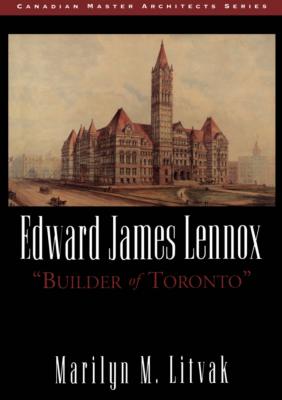Edward James Lennox. Marilyn M. Litvak
Чтение книги онлайн.
Читать онлайн книгу Edward James Lennox - Marilyn M. Litvak страница 6
 Toronto Reference Library
Toronto Reference Library
Illus. 14: Bloor Street Baptist Church, southeast corner of Bloor and North (now Bay) streets, 1882 (demolished).
City of Toronto Archives
Illus. 15: Semi-detached residences for Mrs. Bilton, Gerrard Street East, 1882–83 (demolished).
City of Toronto Archives
Illus. 16: The residence of H.E. Clarke, Esq., 603 Jarvis Street, 1882–83 (demolished).
Metropolitan Toronto Reference Library
Illus. 17: The Massey Manufacturing Company, 701 King Street West, 1883.
City of Toronto Archives
Illus. 18: Residence of Chester Massey, 519 Jarvis Street, 1883. Interior detail.
Marilyn Litvak
Illus. 19: Residence of William Lailey, Esq., 280 Bloor Street West, 1883 (demolished).
City of Toronto Archives
Illus. 20: The Scottish Ontario & Manitoba Land Company, 664–682 Yonge Street, 1883.
John O’Brien
Illus. 21: Scottish Ontario & Manitoba Land Company, 1883. Detail.
John O’Brien
Illus. 22: The Manning Arcade, 22–28 King Street, 1883 (demolished).
City of Toronto Archives
Illus. 23: The Grand Opera House, south side of Adelaide Street between Yonge and Bay streets, 1872–74, architect unknown (demolished).
Archives of Ontario
Illus. 24: Victoria Hall, Queen Street East, 1885 (demolished).
City of Toronto Archives
Illus. 25: The Beatty Building, 3 King Street West, 1886 (demolished).
City of Toronto Archives
2 Toronto’s Third City Hall
The year 1886 marked a turning point in Lennox’s career. He won the competition to design Toronto’s new city hall (now treasured as the city’s “Old City Hall”; Illus. 26), and for the next fifteen years, although he would be involved in many other projects, the City Hall was to be a continuing preoccupation.
Between 1884 and 1886, the city was in pursuit of a design for a new public building. What started out in 1884 as a competition for a county courthouse ended up as a second competition in 1886 for a combined courthouse and municipal building. A select number of the original entrants were invited to submit new or augmented plans, and Lennox, who was then thirty-two years old, emerged as the winner of the second competition.
To ensure his designs were not found “wanting” in any respect, Lennox travelled to “principle [sic] cities in the Eastern States.”1 In May of 1887 he wrote to the chairman of the Court House Committee that he intended to visit Buffalo, Pittsburgh, Washington, Philadelphia, New York, Boston and Albany. On his return he reported to the committee: “I find on the whole that my visit has been somewhat dissappointing [sic], that is, in seeing any building which is laid out superior or ventilated any better than the one which your Committee has seen fit to adopt.”2
Lennox was being disingenuous: he was not “disappointed.” It was his way of telling the building committee that he knew what he was doing and that his building could compete with what the best American architects had to offer. Much of his report was concerned with technical matters and layout rather than style,3 and with good reason. In 1886 an American architect from Buffalo, Richard Waite, had been awarded the commission to build the Ontario Parliament Buildings. This action was considered devious and downright deceitful by Canadian architects. Waite had been part of the jury that found plans submitted by Canadians “wanting, more, it seems, for their handling of mechanical needs than for their overall conception, and design.”4 After the competition closed, Waite submitted plans of his own, and despite the fact that the projected cost of his plans was well above original budget limits, he was awarded the job. A great brouhaha ensued; Canadian architects were insulted and angry. Lennox’s measured statement about his disappointment with the layout and ventilation in public buildings in large American cities was clearly intended as a rebuke to those Ontario government officials who were responsible for the fiasco.
In the same report, E.J. mentioned H.H. Richardson’s Allegheny County Courthouse and Jail (1884—88): “Pittsburg [sic] is the only city of all the cities that has a building that is somewhat similar in its appointments to what your building will be.” Lennox, like many of his contemporaries, was very much influenced by the American architect Henry Hobson Richardson (1838—86). Richardson, trained at the École des Beaux Arts in Paris from 1859 to 1862, is regarded as the pioneer of Romanesque Revival architecture in America. Nonetheless, he was not one to shun naturalistic High Victorian Gothic detailing: to wit, his Trinity Church in Boston, 1872, and Austin Hall, Harvard, 1881–83. Trinity Church in particular was highly influential and established him as an original and at the same time learned architect.5 Lennox took to Richardson’s early version of the Romanesque Revival and executed it in his own projects with great panache. However, it was Richardson’s Allegheny County Courthouse in Pittsburgh, Pennsylvania (Illus. 27), that would prove to be of signal importance to Lennox.
E.J. indicated in his report that he had visited Boston, but made no mention of Trinity Church or Austin Hall at Harvard University. He may or may not have seen Trinity Church. And though he may or may not have visited Austin Hall, he did own a folio book, Art for All and Decorations,6 in which the hall is featured. Lennox’s columns in the front entrance of Toronto’s Old City Hall bear a striking resemblance to Richardson’s multiple-shaft and capital arrangement of Austin Hall.
By July of 1887, E.J.’s plans for the City Hall were complete (Illus. 28 and 29). The city council of 1888, realizing that costs would exceed approved funds, decided that it would have to put the matter before the city’s ratepayers. The council also determined that an accurate account of expected expenditure was needed if the plan was to gain approval.7